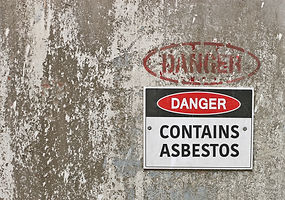



Asbestos Inspections & Testing
Coast Environmental Group (Coast) is an experienced and certified environmental testing and consulting firm that provides asbestos inspections, surveys, air monitoring and testing of potential asbestos containing materials in homes, commercial buildings, schools and government offices. Our experienced and certified technicians can provide asbestos inspections at any type of property. We are capable of sampling for multiple matrices and building materials and can provide sampling of water, soil, dust and air samples for asbestos contamination. We determine where, how many samples to collect and what building material(s) may potentially contain asbestos while keeping our client in compliance with the State of California EPA. The samples are then submitted to our third-party independent NVLAP testing laboratory for expert analysis. The results of the analysis are incorporated into a detailed survey report, which is reviewed by a Certified Asbestos Consultant (CAC) to ensure complete accuracy.
Coast utilizes only Certified Site Surveillance Technicians (CSST) to sample each and every one of our projects. We have performed thousands of inspections for our residential, commercial, and industrial clients. Our qualified and knowledgeable team of professionals work closely with the client throughout the entire process to mitigate your liability in a cost-effective manner.
Asbestos Frequently Asked Questions:
What Is Asbestos?
Asbestos is a natural occurring mineral fiber. It can be positively identified only with a special type of microscope. There are several types of asbestos fibers. In the past, asbestos was added to a variety of products to strengthen them and to provide heat insulation and fire resistance.
How Can Asbestos Affect My Health?
From studies of people who were exposed to asbestos in factories and shipyards, we know that breathing high levels of asbestos fibers can lead to an increased risk of:
Lung Cancer:
· Mesothelioma, a cancer of the lining of the chest and the abdominal cavity; and
· Asbestosis, in which the lungs become scarred with fibrous tissue
The risk of lung cancer and mesothelioma increases with the number of fibers inhaled. The risk of lung cancer from inhaling asbestos fibers is also greater if you smoke. People who get asbestosis have usually been exposed to high levels of asbestos for a long time. The symptoms of these diseases do not usually appear until about 20 to 30 years after the first exposure to asbestos.
Most people exposed to small amounts of asbestos, as we all are in our daily lives, do not develop these health problems. However, if disturbed, asbestos containing building materials may release asbestos fibers, which can be inhaled into the lungs. These fibers can remain imbedded in the lungs for a long time, increasing the risk of disease. Asbestos material that would crumble easily if handled, or that has been sawed, scraped, or sanded into a powder, is more likely to create a health hazard.
Where Asbestos Hazards May Be Found in The Home
· Some roofing and siding shingles are made of asbestos cement.
· Houses built between 1930 and 1950 may have asbestos as insulation.
· Asbestos may be present in textured paint and in patching compounds used on wall and ceiling joints.
Their use was banned in 1977.
· Artificial ashes and embers sold for use in gas-fired fireplaces may contain asbestos.
· Older products such as stove-top pads may have some asbestos compounds.
· Walls and floors around wood burning stoves may be protected with asbestos paper, millboard, or cement sheets.
· Asbestos is found in some vinyl floor tiles and the backing on vinyl sheet flooring and adhesives.
· Hot water and steam pipes in older houses may be coated with an asbestos material or covered with an
asbestos blanket or tape.
· Oil and coal furnaces and door gaskets may have asbestos insulation.
Where Can I Find Asbestos and When Can It Be a Problem?
Most products made today do not contain asbestos. Those few products made which still contain asbestos that could be inhaled are required to be labeled as such. However, until the 1970s, many types of building products and insulation materials used in homes contained asbestos. Common products that might have contained asbestos in the past, and conditions which may release fibers, include:
· STEAM PIPES, BOILERS, and FURNACE DUCTS insulated with an asbestos blanket or asbestos paper tape.
These materials may release asbestos fibers if damaged, repaired, or removed improperly.
· RESILIENT FLOOR TILES (vinyl asbestos, asphalt, and rubber), the backing on VINYL SHEET FLOORING,
and ADHESIVES used for installing floor tile. Sanding tiles can release fibers. So, may scraping or sanding the
backing of sheet flooring during removal.
· CEMENT SHEET, MILLBOARD, and PAPER used as insulation around furnaces and wood burning stoves.
Repairing or removing appliances may release asbestos fibers. So, may cutting, tearing, sanding, drilling, or
sawing insulation.
· DOOR GASKETS in furnaces, wood stoves, and coal stoves. Worn seals can release asbestos fibers during use.
· SOUNDPROOFING OR DECORATIVE MATERIAL sprayed on walls and ceilings. Loose, crumbly, or water-
damaged material may release fibers. So, will sanding, drilling, or scraping the material.
· PATCHING AND JOINT COMPOUNDS for WALLS AND CEILINGS, and TEXTURED PAINTS. Sanding, scraping,
or drilling these surfaces may release asbestos.
· ASBESTOS CEMENT ROOFING, SHINGLES, and SIDING. These products are not likely to release asbestos
fibers unless sawed, dilled, or cut.
· ARTIFICIAL ASHES AND EMBERS sold for use in gas-fired fireplaces. Also, other older household products
such as FIREPROOF GLOVES, STOVE-TOP PADS, IRONING BOARD COVERS, and certain HAIRDRYERS.
· AUTOMOBILE BRAKE PADS AND LININGS, CLUTCH FACINGS, and GASKETS
To ask a question or schedule an appointment call 1-800-784-3336 or email us at admin@CoastEnviro.com
